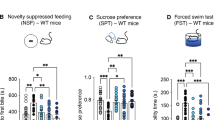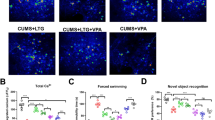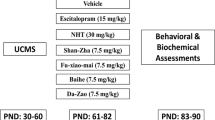Abstract
Current pharmacotherapies for depression exhibit slow onset, side effects and limited efficacy. Therefore, identification of novel fast-onset antidepressants is desirable. GLO1 is a ubiquitous cellular enzyme responsible for the detoxification of the glycolytic byproduct methylglyoxal (MG). We have previously shown that MG is a competitive partial agonist at GABA-A receptors. We examined the effects of genetic and pharmacological inhibition of GLO1 in two antidepressant assay models: the tail suspension test (TST) and the forced swim test (FST). We also examined the effects of GLO1 inhibition in three models of antidepressant onset: the chronic FST (cFST), chronic mild stress (CMS) paradigm and olfactory bulbectomy (OBX). Genetic knockdown of Glo1 or pharmacological inhibition using two structurally distinct GLO1 inhibitors (S-bromobenzylglutathione cyclopentyl diester (pBBG) or methyl-gerfelin (MeGFN)) reduced immobility in the TST and acute FST. Both GLO1 inhibitors also reduced immobility in the cFST after 5 days of treatment. In contrast, the serotonin reuptake inhibitor fluoxetine (FLX) reduced immobility after 14, but not 5 days of treatment. Furthermore, 5 days of treatment with either GLO1 inhibitor blocked the depression-like effects induced by CMS on the FST and coat state, and attenuated OBX-induced locomotor hyperactivity. Finally, 5 days of treatment with a GLO1 inhibitor (pBBG), but not FLX, induced molecular markers of the antidepressant response including brain-derived neurotrophic factor (BDNF) induction and increased phosphorylated cyclic-AMP response-binding protein (pCREB) to CREB ratio in the hippocampus and medial prefrontal cortex (mPFC). Our findings indicate that GLO1 inhibitors may provide a novel and fast-acting pharmacotherapy for depression.
This is a preview of subscription content, access via your institution
Access options
Subscribe to this journal
Receive 12 print issues and online access
$259.00 per year
only $21.58 per issue
Buy this article
- Purchase on Springer Link
- Instant access to full article PDF
Prices may be subject to local taxes which are calculated during checkout





Similar content being viewed by others
References
Kessler RC, Chiu WT, Demler O, Merikangas KR, Walters EE . Prevalence, severity, and comorbidity of 12-month DSM-IV disorders in the National Comorbidity Survey Replication. Arch Gen Psychiatry 2005; 62: 617–627.
Kessler RC, Petukhova M, Sampson NA, Zaslavsky AM, Wittchen H-U . Twelve-month and lifetime prevalence and lifetime morbid risk of anxiety and mood disorders in the United States. Int J Methods Psychiatr Res 2012; 21: 169–184.
Berton O, Nestler EJ . New approaches to antidepressant drug discovery: beyond monoamines. Nat Rev Neurosci 2006; 7: 137–151.
Martinowich K, Jimenez DV, Zarate Ca, Manji HK . Rapid antidepressant effects: moving right along. Mol Psychiatry 2013; 18: 856–863.
Thornalley PJ . Pharmacology of methylglyoxal: formation, modification of proteins and nucleic acids, and enzymatic detoxification—a role in pathogenesis and antiproliferative chemotherapy. Gen Pharmacol 1996; 27: 565–573.
Distler MG, Plant LD, Sokoloff G, Hawk AJ, Aneas I, Wuenschell GE et al. Glyoxalase 1 increases anxiety by reducing GABA A receptor agonist methylglyoxal. J Clin Invest 2012; 122: 2306–2315.
Benton CS, Miller BH, Skwerer S, Suzuki O, Schultz LE, Cameron MD et al. Evaluating genetic markers and neurobiochemical analytes for fluoxetine response using a panel of mouse inbred strains. Psychopharmacology 2012; 221: 297–315.
Yang Y, Yang D, Tang G, Zhou C, Cheng K, Zhou J et al. Proteomics reveals energy and glutathione metabolic dysregulation in the prefrontal cortex of a rat model of depression. Neuroscience 2013; 247: 191–200.
Patki G, Solanki N, Atrooz F, Allam F, Salim S . Depression, anxiety-like behavior and memory impairment are associated with increased oxidative stress and inflammation in a rat model of social stress. Brain Res 2013; 1539: 73–86.
Hovatta I, Tennant RS, Helton R, Marr Ra, Singer O, Redwine JM et al. Glyoxalase 1 and glutathione reductase 1 regulate anxiety in mice. Nature 2005; 438: 662–666.
Williams R, Lim JE, Harr B, Wing C, Walters R, Distler MG et al. A common and unstable copy number variant is associated with differences in Glo1 expression and anxiety-like behavior. PLoS ONE 2009; 4: e4649.
Kendler KS, Gardner CO, Gatz M, Pedersen NL . The sources of co-morbidity between major depression and generalized anxiety disorder in a Swedish national twin sample. Psychol Med 2007; 37: 453–462.
Demirkan A, Penninx BWJH, Hek K, Wray NR, Amin N, Aulchenko YS et al. Genetic risk profiles for depression and anxiety in adult and elderly cohorts. Mol Psychiatry 2011; 16: 773–783.
Kent JM, Mathew SJ, Gorman JM . Molecular targets in the treatment of anxiety. Biol Psychiatry 2002; 52: 1008–1030.
El-Osta A, Brasacchio D, Yao D, Pocai A, Jones PL, Roeder RG et al. Transient high glucose causes persistent epigenetic changes and altered gene expression during subsequent normoglycemia. J Exp Med 2008; 205: 2409–2417.
McMurray KMJ, Sidhu PS, Cook JM, Arnold LA, Palmer AA . Genetic and pharmacological manipulation of glyoxalase 1 regulates voluntary ethanol consumption in mice. Addict Biol 2017; 22: 381–389.
Kawatani M, Okumura H, Honda K, Kanoh N, Muroi M, Dohmae N et al. The identification of an osteoclastogenesis inhibitor through the inhibition of glyoxalase I. Proc Natl Acad Sci U S A 2008; 105: 11691–11696.
Kanoh N, Suzuki T, Kawatani M, Katou Y, Osada H, Iwabuchi Y . Dual structure-activity relationship of osteoclastogenesis inhibitor methyl gerfelin based on teg scanning. Bioconjug Chem 2013; 24: 44–52.
Opal MD, Klenotich SC, Morais M, Bessa J, Winkle J, Doukas D et al. Serotonin 2C receptor antagonists induce fast-onset antidepressant effects. Mol Psychiatry 2013; 19: 1106–1114.
Dulawa SC, Holick KA, Gundersen B, Hen R . Effects of chronic fluoxetine in animal models of anxiety and depression. Neuropsychopharmacology 2004; 29: 1321–1330.
Cryan JF, Mombereau C, Vassout A . The tail suspension test as a model for assessing antidepressant activity: review of pharmacological and genetic studies in mice. Neurosci Biobehav Rev 2005; 29: 571–625.
Jiao J, Opal MD, Dulawa SC . Gestational environment programs adult depression-like behavior through methylation of the calcitonin gene-related peptide gene. Mol Psychiatry 2012; 18: 1–8.
Cryan JF, Holmes A . The ascent of mouse: advances in modelling human depression and anxiety. Nat Rev Drug Discov 2005; 4: 775–790.
Duman RS, Voleti B . Signaling pathways underlying the pathophysiology and treatment of depression: novel mechanisms for rapid-acting agents. Trends Neurosci 2012; 35: 47–56.
Browne Ca, Lucki I . Antidepressant effects of ketamine: mechanisms underlying fast-acting novel antidepressants. Front Pharmacol 2013; 4: 1–18.
Jiao J, Nitzke AM, Doukas DG, Seiglie MP, Dulawa SC . Antidepressant response to chronic citalopram treatment in eight inbred mouse strains. Psychopharmacology 2011; 213: 509–520.
Jarosik J, Legutko B, Unsicker K, von Bohlen Und, Halbach O . Antidepressant-mediated reversal of abnormal behavior and neurodegeneration in mice following olfactory bulbectomy. Exp Neurol 2007; 204: 20–28.
Cryan JF, Markou A, Lucki I . Assessing antidepressant activity in rodents: recent developments and future needs. Trends Pharmacol Sci 2002; 23: 238–245.
Dulawa SC, Hen R . Recent advances in animal models of chronic antidepressant effects: the novelty-induced hypophagia test. Neurosci Biobehav Rev 2005; 29: 771–783.
Marcia JR, Stephanie CD . Identifying fast-onset antidepressants using Rodent models. Mol Psychiatry 2017 (in press).
Klumpers UMH, Veltman DJ, Drent ML, Boellaard R, Comans EFI, Meynen G et al. Reduced parahippocampal and lateral temporal GABAA-[11C]flumazenil binding in major depression: preliminary results. Eur J Nucl Med Mol Imaging 2010; 37: 565–574.
Sanacora G, Mason GF, Rothman DL, Krystal JH . Increased occipital cortex GABA concentrations in depressed patients after therapy with selective serotonin reuptake inhibitors. Am J Psychiatry 2002; 159: 663–665.
Möhler H . The GABA system in anxiety and depression and its therapeutic potential. Neuropharmacology 2012; 62: 42–53.
Kalueff AV, Nutt DJ . Role of GABA in anxiety and depression. Depress Anxiety 2007; 24: 495–517.
Ahmed El zahaf N, Salem Elhwuegi A . The effect of GABAmimetics on the duration of immobility in the forced swim test in albino mice. Libyan J Med 2014; 9: 23480.
Petty F, Trivedi MH, Fulton M, Rush AJ . Benzodiazepines as antidepressants: does GABA play a role in depression? Biol Psychiatry 1995; 38: 578–591.
Guidotti A, Dong E, Matsumoto K, Pinna G, Rasmusson AM, Costa E . The socially-isolated mouse: a model to study the putative role of allopregnanolone and 5alpha-dihydroprogesterone in psychiatric disorders. Brain Res - Brain Res Rev 2001; 37: 110–115.
Khisti RT, Chopde CT, Jain SP . Antidepressant-like effect of the neurosteroid 3 alpha-hydroxy-5 alpha-pregnan-20-one in mice forced swim test. Pharmacol Biochem Behav 2000; 67: 137–143.
Rodriguez-Landa JF, Contreras CM, Bernal-Morales B, Gutierrez-Garcia AG, Saavedra M . Allopregnanolone reduces immobility in the forced swimming test and increases the firing rate of lateral septal neurons through actions on the GABAA receptor in the rat. J Psychopharmacol 2006; 21: 76–84.
Fischell J, Van Dyke AM, Kvarta MD, LeGates TA, Thompson SM . Rapid antidepressant action and restoration of excitatory synaptic strength after chronic stress by negative modulators of alpha5-containing GABAA receptors. Neuropsychopharmacology 2015; 40: 2499–2509.
Fava M, Schaefer K, Huang H, Wilson A, Iosifescu DV, Mischoulon D et al. A post hoc analysis of the effect of nightly administration of eszopiclone and a selective serotonin reuptake inhibitor in patients with insomnia and anxious depression. J Clin Psychiatry 2011; 72: 473–479.
Ahmed N, Thornalley PJ . Advanced glycation endproducts: what is their relevance to diabetic complications? Diabetes Obes Metab 2007; 9: 233–245.
Brownlee M . Biochemistry and molecular cell biology of diabetic complications. Nature 2001; 414: 813–820.
McMurray KMJ, Distler MG, Sidhu PS, Cook JM, Arnold La, Palmer AA et al. Glo1 inhibitors for neuropsychiatric and anti-epileptic drug development. Biochem Soc Trans 2014; 42: 461–467.
Distler MG, Palmer AA . Role of Glyoxalase 1 (Glo1) and methylglyoxal (MG) in behavior: recent advances and mechanistic insights. Front Genet 2012; 3: 250.
Duman RS, Monteggia LM . A neurotrophic model for stress-related mood disorders. Biol Psychiatry 2006; 59: 1116–1127.
Polyakova M, Stuke K, Schuemberg K, Mueller K, Schoenknecht P, Schroeter ML . BDNF as a biomarker for successful treatment of mood disorders: a systematic & quantitative meta-analysis. J Affect Disord 2015; 174: 432–440.
Nibuya M, Morinobu S, Duman RS . Regulation of BDNF and trkB mRNA in rat brain by chronic electroconvulsive seizure and antidepressant drug treatments. J Neurosci 1995; 15: 7539–7547.
Zhou W, Wang N, Yang C, Li XM, Zhou ZQ, Yang JJ . Ketamine-induced antidepressant effects are associated with AMPA receptors-mediated upregulation of mTOR and BDNF in rat hippocampus and prefrontal cortex. Eur Psychiatry 2014; 29: 419–423.
Autry AE, Adachi M, Nosyreva E, Na ES, Los MF, Cheng P et al. NMDA receptor blockade at rest triggers rapid behavioural antidepressant responses. Nature 2011; 475: 91–95.
Pascual-Brazo J, Castro E, Díaz A, Valdizán EM, Pilar-Cuéllar F, Vidal R et al. Modulation of neuroplasticity pathways and antidepressant-like behavioural responses following the short-term (3 and 7 days) administration of the 5-HT4 receptor agonist RS67333. Int J Neuropsychopharmacol 2012; 15: 631–643.
Di Loreto S, Zimmitti V, Sebastiani P, Cervelli C, Falone S, Amicarelli F . Methylglyoxal causes strong weakening of detoxifying capacity and apoptotic cell death in rat hippocampal neurons. Int J Biochem Cell Biol 2008; 40: 245–257.
Distler MG, Gorfinkle N, Papale LA, Wuenschell GE, Termini J, Escayg A et al. Glyoxalase 1 and its substrate methylglyoxal are novel regulators of seizure susceptibility. Epilepsia 2013; 54: 649–657.
Acknowledgements
We thank Dr Michael Brownlee for the Glo1KD mice and both Charissa Newkirk and Shibani Chettri for technical assistance with these studies. This work was supported by NIH grants T32DA007255 (KMJM), T32MH020065 (MJR), F32AA025515 (AMBL), R01MH079103 (AAP), R01MH096463 (JMC), R01NS076517 a NARSAD Independent Investigator Award (SCD), a NARSAD Young Investigator Award (MJR) and an IMHRO Rising Star Depression Research Award in Memory of George Largay (SCD).
Author information
Authors and Affiliations
Corresponding author
Ethics declarations
Competing interests
Drs Palmer and McMurray have applied for a patent-related manipulation of GLO1 to treat various neurological and psychiatric disorders. The remaining authors declare no conflict of interest.
Additional information
Supplementary Information accompanies the paper on the Molecular Psychiatry website
Supplementary information
Rights and permissions
About this article
Cite this article
McMurray, K., Ramaker, M., Barkley-Levenson, A. et al. Identification of a novel, fast-acting GABAergic antidepressant. Mol Psychiatry 23, 384–391 (2018). https://doi.org/10.1038/mp.2017.14
Received:
Revised:
Accepted:
Published:
Issue Date:
DOI: https://doi.org/10.1038/mp.2017.14
This article is cited by
-
Prolonged HPA axis dysregulation in postpartum depression associated with adverse early life experiences: a cross-species translational study
Nature Mental Health (2024)
-
Comparing the effect of fluoxetine, escitalopram, and sertraline, on the level of BDNF and depression in preclinical and clinical studies: a systematic review
European Journal of Clinical Pharmacology (2024)
-
Differential expression of Dusp1 and immediate early response genes in the hippocampus of rats, subjected to forced swim test
Scientific Reports (2023)
-
Single-nucleus genomics in outbred rats with divergent cocaine addiction-like behaviors reveals changes in amygdala GABAergic inhibition
Nature Neuroscience (2023)
-
Sigma-1 receptor ligands improves ventricular repolarization-related ion remodeling in rats with major depression disorder
Psychopharmacology (2021)



